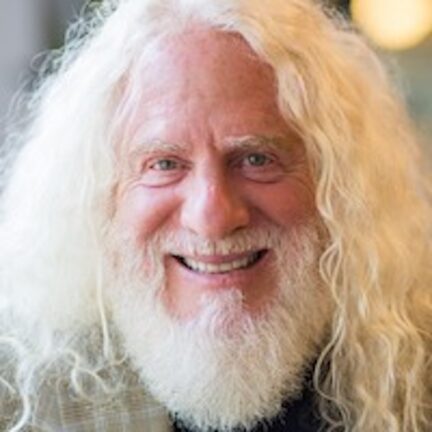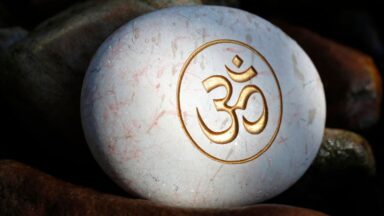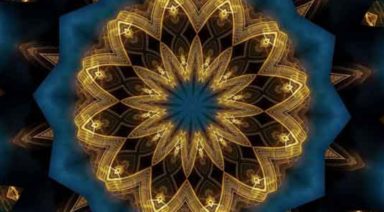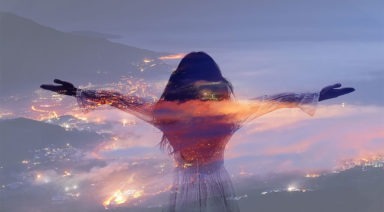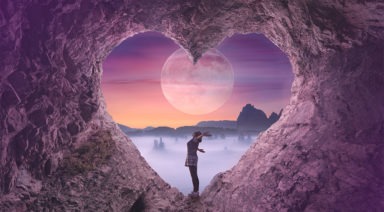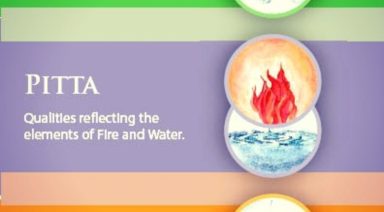What’s in a Mantra?

Most yogis know that chanting Om is chanting a mantra and that the word mantra comes from two Sanskrit words: man meaning mind; and tra meaning vehicle or instrument – a tool to transport the mind from a state of activity to one of stillness and silence. We get the words train, travel, and transportation from the Sanskrit root tra. But Om is not simply a word – it’s a seed sound known as a bija – heralding all of the unbounded universe in its very utterance. So let’s dive into the deep end of the mantra pool!
Most mantras are comprised of the fifty letters of the Sanskrit alphabet and can consist of a single letter, a syllable or string of syllables, a word, or a whole sentence. Typically, most mantras are sounds, syllables, or vibrations that don’t necessarily have a meaning. Their value lies in their vibrational quality, not in any meaning that humans, society, culture, or civilization has placed on them over the last few thousand years. For this reason they go beyond the state of human existence on this planet, and they take you deeper because they are vibrations that have existed since the dawn of creation.
The Hymn of the Universe
Om – often referred to as the hymn of the universe – is considered the ultimate vibration because it contains every vibration that has ever existed and every vibration that will ever exist. It’s pure yoga – union. Just as white light contains all the colors of the spectrum, Om contains every sound in the vibrational spectrum – even those we can’t hear with our ears. The cover of Pink Floyd’s Dark Side of the Moon represents this brilliantly as it shows the white light coming into a prism and all the colors of the spectrum coming out the other side. The same could be said for Om – it’s the white light of sound.
Historically, Om is first mentioned in the twelve verses of the ancient Vedic text the Mandukya Upanishads, which explains the three basic states of consciousness: waking, sleeping, and dreaming. In its original spelling and pronunciation, AUM (pronounced ahh-uhh-mmm) is a blending of those three states of consciousness into the one-ness of three distinct syllables: A, U, and M. These three vibrations also represent the three stages of life: birth, living, and death.
The vibration A (pronounced ahh, like the sound you make opening your mouth for the doctor) represents the waking state and the beginning of all things. The letter A is the first letter of most every alphabet, the first letter of the Rig Veda, the Koran, Homer’s Odyssey – even the New Testament! The vibration A heralds creation…the beginning. Vedic sages refer to it as the a-kara and it represents the realm of form and shape – the physical realm.
The vibration U (pronounced oo) is referred to as the u-kara and represents the dream state, the realm that is devoid of form or shape – the realms of air, water, fire, dreams – ever-changing aspects of the formless world around us.
The vibration M is known as the ma-kara, which represents the state of deep sleep – neither form or formless like the other two realms but beyond shape or shapelessness – the realm of consciousness in hibernation, waiting to unfold.
In Sanskrit grammar, when the letters A and U are combined in writing, they are translated as the letter O. That is why we so often see Om written instead of Aum. Over thousands of years, the writing of Aum has taken a back seat to Om, and that has led to Om being the sound that is most often chanted by both Western students and teachers of yoga, meditation, and Vedanta.
When the three individual vibrations are combined, a fourth vibration is created like a chord in music made up of individual notes. AUM (pronounced ahhh–uhhh–mmmm) represents the fourth state of consciousness – transcendent consciousness or turiya – what we call enlightenment or one-ness. In Vedanta, it’s the unity of the divine made up of its three components: creation; preservation; destruction (and rebirth). The chanting of this mantra heralds our universality, which is why we usually chant Om before and/or after meditation and yoga practice, and when we read sacred, ancient texts. By repeating a vibration or sound over and over, it will become part of your physiology; it will become your mind; it will become *you. * It will lose all meaning, all definition, and all relevance. There will be no separation between you and the vibration that is resonating right now.
Chanting Om (out loud or silently) is an ideal reminder of our universality.
What Is the Om Mantra: Origin and Meaning

The mantra “Om” is much more than a simple syllable in yoga practice; it is an ancestral link with the universe and the divine. This article explores the secrets of this powerful mantra, delving into its origin, pronunciation, and meaning in yoga and spirituality.
Table of Contents
- Meaning of the Om Mantra
- What Is the Origin of the Om Mantra?
- How Is 'Om' Pronounced Correctly?
- What Does Om Mean in Yoga?
- Why Is Om Chanted in Yoga Classes?
- Benefits of Chanting the Om Mantra
- What Does the Om Symbol (ॐ) Represent?
Meaning of the Om Mantra
The Om mantra, symbolized by the sacred ॐ, is one of the most ancient and revered mantras in the spiritual traditions of India. It represents the essence of the universe, being a primordial sound that encapsulates truth and ultimate reality. In its vibration, Om encompasses everything that exists and everything that does not exist. This sacred sound is a synthesis of the spiritual and the material, symbolizing the union of the individual soul with the Divine, the Brahman, the ultimate reality.
More than just a syllable, Om is a symbol of connection and unity. In spiritual practices such as yoga and meditation, chanting Om helps align individual energies with those of the universe. Each repetition of Om is a reminder of our relationship with creation and a call for harmony and inner peace. It acts as a bridge between the material and spiritual worlds, facilitating the path to enlightenment and profound self-understanding.
What Is the Origin of the Om Mantra?
The origin of the Om mantra dates back to the ancient scriptures of India, such as the Vedas and the Upanishads, which are thousands of years old. In these texts, Om is presented as a cosmic sound, the original sound of the universe from which everything else emerged. This concept is found in various Dharmic philosophies and religions, such as Hinduism, Buddhism, and Jainism, where Om is considered the root of all spiritual knowledge.
In Hindu philosophy, Om represents the whole, the totality of existence, and is associated with the most important gods such as Brahma, Vishnu, and Shiva. In Buddhism, especially in tantric traditions, it holds great importance as part of longer mantras. This universality of Om underscores its significance in spiritual and philosophical practices, being a symbol of unity, peace, and spiritual knowledge throughout the ages.
How Is “Om” Pronounced Correctly?
Correct pronunciation of Om is essential for its effect and meaning. The syllable is pronounced “AUM” and consists of three sounds: A (ahh), U (ooh), and M (mmm). These three sounds symbolize different aspects of divinity and existence. The sound “A” represents the beginning, creation; “U” symbolizes preservation, and “M” represents transformation or destruction. When combined, these sounds represent the complete cycle of existence.
When pronouncing Om, the sound begins with an open and deep “A,” which starts in the throat and opens toward the chest. The sound transforms into “U,” moving toward the palate and vibrating in the middle of the mouth. Finally, the “M” closes the mantra, with a vibration that resonates in the front of the mouth and skull. This process not only has spiritual significance but also helps align and calm the mind and body, preparing them for meditation or yoga practice.
What Does Om Mean in Yoga?
In yoga, Om represents much more than a simple chanting or meditation practice. It is a symbol of profound connection between the practitioner and the universe. By chanting Om at the beginning or end of a yoga session, the goal is to harmonize the mind, body, and spirit with universal energies.
This sacred sound acts as a catalyst for mental tranquility and concentration, creating a space of serenity and focus for practice. Om in yoga not only prepares the body and mind for the session but also symbolizes the intention to unify the individual self with the cosmic whole, facilitating a deeper and more enriching experience.
Why Is Om Chanted in Yoga Classes?
Chanting Om in yoga classes serves several purposes. First, it creates a bond of connection and unity among participants, establishing a collective atmosphere of focus and serenity. Additionally, the vibrant sound of Om helps calm the mind and center attention, clearing mental and emotional noise.
Chanting Om is also considered beneficial for physical health, as the vibration generated can help relax muscles and calm the nervous system. This practice is not only a symbolic introduction or conclusion to the yoga session but also a powerful tool for deepening the spiritual and physical experience of yoga.
Benefits of Chanting the Om Mantra
Reciting the Om mantra has multiple benefits for both the mind and body:
- Reduces stress and anxiety: The vibration of Om induces relaxation, decreasing tension and mental restlessness.
- Improves concentration: The focus required to correctly chant Om helps enhance attention and mental clarity.
- Encourages spiritual connection: Repeating Om can intensify the feeling of spiritual connection and unity with the universe.
- Aligns body energy: The vibration of Om can help balance and align the chakras or energy centers in the body.
- Promotes respiratory health: Chanting Om involves conscious breath control, which can improve lung capacity and breathing.
What Does the Om Symbol (ॐ) Represent?
The Om symbol (ॐ) is a rich and complex visual representation of the Om sound. Each part of the symbol has a specific meaning: the lower curve symbolizes the waking state, the upper curve represents the deep sleep state, and the curve extending outward symbolizes the dream state. The crescent and dot at the top symbolize the transcendental state, a level of consciousness beyond conventional physical and mental states.
This symbol not only represents different states of consciousness but also the essential aspects of the universe: matter, soul, and God. The Om symbol is a visual reminder of the connection between the microcosm (the individual) and the macrocosm (the universe). In spiritual practice and daily life, the Om symbol serves as a constant reminder of our essential nature and our connection with everything that exists.
Whether through chanting or visual representation, Om is a timeless tool for those seeking harmony, balance, and a deeper connection with themselves and the universe.

